Toán 10 Bài 3: Tích của một số với một vectơ Giải SGK Toán 10 trang 97 - Tập 1 sách Chân trời sáng tạo
Toán 10 bài 3 Chân trời sáng tạo trang 97 giúp các bạn học sinh có thêm nhiều gợi ý tham khảo để trả lời các câu hỏi phần thực hành và 7 bài tập trong SGK bài Tích của một số với một vectơ .
Giải Toán 10 Chân trời sáng tạo bài 3 trang 97 được biên soạn với các lời giải chi tiết, đầy đủ và chính xác bám sát chương trình sách giáo khoa môn Toán 10 tập 1. Giải Toán 10 bài 3 Chân trời sáng tạo là tài liệu cực kì hữu ích hỗ trợ các em học sinh lớp 10 trong quá trình giải bài tập. Đồng thời phụ huynh có thể sử dụng để hướng dẫn con em học tập và đổi mới phương pháp giải phù hợp hơn. Vậy sau đây là nội dung chi tiết giải Toán 10 bài 3 Tích của một số với một vectơ mời các bạn cùng theo dõi.
Toán 10 Bài 3: Tích của một số với một vectơ
- Trả lời câu hỏi Thực hành Toán 10 Bài 3
- Giải Toán 10 trang 97 Chân trời sáng tạo - Tập 1
- Lý thuyết Tích của một số với một vectơ
Trả lời câu hỏi Thực hành Toán 10 Bài 3
Thực hành 1
Cho hai vecto ![]() \(\overrightarrow a ;\overrightarrow b\) và một điểm M như Hình 3.
\(\overrightarrow a ;\overrightarrow b\) và một điểm M như Hình 3.
a) Hãy vẽ các vecto ![]() \(\overrightarrow {MN} = 3\overrightarrow a ;\overrightarrow {MP} = - 3\overrightarrow b\)
\(\overrightarrow {MN} = 3\overrightarrow a ;\overrightarrow {MP} = - 3\overrightarrow b\)
b) Cho biết mỗi ô vương có cạnh bằng 1. Tính ![]() \(\left| {3\overrightarrow b } \right|;\left| { - 3\overrightarrow b } \right|;\left| {2\overrightarrow a + 2\overrightarrow b } \right|\)
\(\left| {3\overrightarrow b } \right|;\left| { - 3\overrightarrow b } \right|;\left| {2\overrightarrow a + 2\overrightarrow b } \right|\)
Gợi ý đáp án
a) Ta có:  \(\overrightarrow {MN} = 3\overrightarrow a \Rightarrow \left\{ {\begin{array}{*{20}{c}}
{\overrightarrow {MN} \nearrow \nearrow \overrightarrow a } \\
{\left| {\overrightarrow {MN} } \right| = 3\left| {\overrightarrow a } \right|}
\end{array}} \right.\)
\(\overrightarrow {MN} = 3\overrightarrow a \Rightarrow \left\{ {\begin{array}{*{20}{c}}
{\overrightarrow {MN} \nearrow \nearrow \overrightarrow a } \\
{\left| {\overrightarrow {MN} } \right| = 3\left| {\overrightarrow a } \right|}
\end{array}} \right.\)
Từ M vẽ đường thẳng song song với giá của ![]() \(\overrightarrow a\), lấy điểm N trên đường thẳng đó cùng hướng với vecto
\(\overrightarrow a\), lấy điểm N trên đường thẳng đó cùng hướng với vecto ![]() \(\overrightarrow a\) thỏa mãn
\(\overrightarrow a\) thỏa mãn ![]() \(\left| {\overrightarrow {MN} } \right| = 3\left| {\overrightarrow a } \right|\)
\(\left| {\overrightarrow {MN} } \right| = 3\left| {\overrightarrow a } \right|\)
Ta lại có:  \(\overrightarrow {MP} = - 3\overrightarrow b \Rightarrow \left\{ {\begin{array}{*{20}{c}}
{\overrightarrow {MP} \nearrow \swarrow \overrightarrow b } \\
{\left| {\overrightarrow {MP} } \right| = 3\left| {\overrightarrow b } \right|}
\end{array}} \right.\)
\(\overrightarrow {MP} = - 3\overrightarrow b \Rightarrow \left\{ {\begin{array}{*{20}{c}}
{\overrightarrow {MP} \nearrow \swarrow \overrightarrow b } \\
{\left| {\overrightarrow {MP} } \right| = 3\left| {\overrightarrow b } \right|}
\end{array}} \right.\)
Từ M vẽ đường thẳng song song với giá của ![]() \(\overrightarrow b\), lấy điểm P trên đường thẳng đó ngược hướng với vecto
\(\overrightarrow b\), lấy điểm P trên đường thẳng đó ngược hướng với vecto ![]() \(\overrightarrow b\) thỏa mãn
\(\overrightarrow b\) thỏa mãn ![]() \(\left| {\overrightarrow {MP} } \right| = 3\left| {\overrightarrow b } \right|\)
\(\left| {\overrightarrow {MP} } \right| = 3\left| {\overrightarrow b } \right|\)
b) Đường chéo mỗi ô vuông có độ dài là ![]() \(\sqrt 2\)
\(\sqrt 2\)
Ta có:  \(\left\{ {\begin{array}{*{20}{c}}
{\left| {\overrightarrow a } \right| = 2} \\
{\left| {\overrightarrow b } \right| = 2}
\end{array}} \right.\)
\(\left\{ {\begin{array}{*{20}{c}}
{\left| {\overrightarrow a } \right| = 2} \\
{\left| {\overrightarrow b } \right| = 2}
\end{array}} \right.\)
Khi đó:  \(\left\{ {\begin{array}{*{20}{c}}
{\left| {3\overrightarrow b } \right| = 3\left| {\overrightarrow b } \right| = 3\sqrt 2 } \\
{\left| { - 3\overrightarrow b } \right| = \left| { - 3} \right|\left| {\overrightarrow b } \right| = 3\sqrt 2 }
\end{array}} \right.\)
\(\left\{ {\begin{array}{*{20}{c}}
{\left| {3\overrightarrow b } \right| = 3\left| {\overrightarrow b } \right| = 3\sqrt 2 } \\
{\left| { - 3\overrightarrow b } \right| = \left| { - 3} \right|\left| {\overrightarrow b } \right| = 3\sqrt 2 }
\end{array}} \right.\)
Ta có: ![]() \(2\overrightarrow a + 2\overrightarrow b = 2\left( {\overrightarrow a + \overrightarrow b } \right)\) (*)
\(2\overrightarrow a + 2\overrightarrow b = 2\left( {\overrightarrow a + \overrightarrow b } \right)\) (*)
Đặt ![]() \(\overrightarrow a = \overrightarrow {AC} ;\overrightarrow b = \overrightarrow {AB}\) kí hiệu như hình vẽ:
\(\overrightarrow a = \overrightarrow {AC} ;\overrightarrow b = \overrightarrow {AB}\) kí hiệu như hình vẽ:
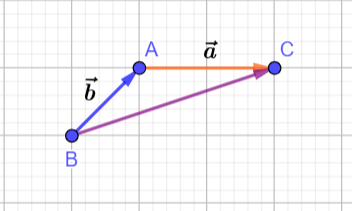
Ta có: ![]() \(\overrightarrow a + \overrightarrow b = \overrightarrow {AC} + \overrightarrow {AB} = \overrightarrow {BA} + \overrightarrow {AC} = \overrightarrow {BC} \left( {**} \right)\)
\(\overrightarrow a + \overrightarrow b = \overrightarrow {AC} + \overrightarrow {AB} = \overrightarrow {BA} + \overrightarrow {AC} = \overrightarrow {BC} \left( {**} \right)\)
Từ (*) và (**)
=> ![]() \(\left| {2\overrightarrow a + 2\overrightarrow b } \right| = \left| {2\left( {\overrightarrow a + \overrightarrow b } \right)} \right| = \left| {2\overrightarrow {BC} } \right| = 2BC\)
\(\left| {2\overrightarrow a + 2\overrightarrow b } \right| = \left| {2\left( {\overrightarrow a + \overrightarrow b } \right)} \right| = \left| {2\overrightarrow {BC} } \right| = 2BC\)
Xét tam giác ABC ta có:
![]() \(\widehat {BAC} = {45^0} + {90^0} = {135^0}\)
\(\widehat {BAC} = {45^0} + {90^0} = {135^0}\)
Áp dụng định lí cosin trong tam giác ta có:
 \(\begin{matrix}
B{C^2} = A{B^2} + A{C^2} - 2AB.AC\cos A \hfill \\
\Rightarrow B{C^2} = {\left( {\sqrt 2 } \right)^2} + {2^2} - 2\left( {\sqrt 2 } \right).2.\cos {135^0} = 10 \hfill \\
\Rightarrow BC = \sqrt {10} \hfill \\
\Rightarrow \left| {2\overrightarrow a + 2\overrightarrow b } \right| = 2BC = 2\sqrt {10} \hfill \\
\end{matrix}\)
\(\begin{matrix}
B{C^2} = A{B^2} + A{C^2} - 2AB.AC\cos A \hfill \\
\Rightarrow B{C^2} = {\left( {\sqrt 2 } \right)^2} + {2^2} - 2\left( {\sqrt 2 } \right).2.\cos {135^0} = 10 \hfill \\
\Rightarrow BC = \sqrt {10} \hfill \\
\Rightarrow \left| {2\overrightarrow a + 2\overrightarrow b } \right| = 2BC = 2\sqrt {10} \hfill \\
\end{matrix}\)
Thực hành 2
Cho tam giác ABC. Chứng minh G là trọng tâm của tam giác ABC khi và chỉ khi ![]() \(\overrightarrow {MA} + \overrightarrow {MB} + \overrightarrow {MC} = 3\overrightarrow {MG}\)
\(\overrightarrow {MA} + \overrightarrow {MB} + \overrightarrow {MC} = 3\overrightarrow {MG}\)
Gợi ý đáp án
Hình vẽ minh họa:

Giả sử G là trọng tâm tam giác ABC
=> ![]() \(\overrightarrow {GA} + \overrightarrow {GB} + \overrightarrow {GC} = \overrightarrow 0\)
\(\overrightarrow {GA} + \overrightarrow {GB} + \overrightarrow {GC} = \overrightarrow 0\)
Khi đó:
 \(\begin{matrix}
\overrightarrow {MA} + \overrightarrow {MB} + \overrightarrow {MC} \hfill \\
= \left( {\overrightarrow {MG} + \overrightarrow {GA} } \right) + \left( {\overrightarrow {MG} + \overrightarrow {GB} } \right) + \left( {\overrightarrow {MG} + \overrightarrow {GC} } \right) \hfill \\
= 3\overrightarrow {MG} + \left( {\overrightarrow {GA} + \overrightarrow {GB} + \overrightarrow {GC} } \right) \hfill \\
= 3\overrightarrow {MG} + \overrightarrow 0 = 3\overrightarrow {MG} \hfill \\
\end{matrix}\)
\(\begin{matrix}
\overrightarrow {MA} + \overrightarrow {MB} + \overrightarrow {MC} \hfill \\
= \left( {\overrightarrow {MG} + \overrightarrow {GA} } \right) + \left( {\overrightarrow {MG} + \overrightarrow {GB} } \right) + \left( {\overrightarrow {MG} + \overrightarrow {GC} } \right) \hfill \\
= 3\overrightarrow {MG} + \left( {\overrightarrow {GA} + \overrightarrow {GB} + \overrightarrow {GC} } \right) \hfill \\
= 3\overrightarrow {MG} + \overrightarrow 0 = 3\overrightarrow {MG} \hfill \\
\end{matrix}\)
Chứng minh chiều ngược lại
Giả sử tam giác ABC có hai điểm M và G bất kì thỏa mãn ![]() \(\overrightarrow {MA} + \overrightarrow {MB} + \overrightarrow {MC} = 3\overrightarrow {MG}\)
\(\overrightarrow {MA} + \overrightarrow {MB} + \overrightarrow {MC} = 3\overrightarrow {MG}\)
Khi đó:
 \(\begin{matrix}
\overrightarrow {MA} + \overrightarrow {MB} + \overrightarrow {MC} - 3\overrightarrow {MG} = \overrightarrow 0 \hfill \\
\Rightarrow \left( {\overrightarrow {MA} - \overrightarrow {MG} } \right) + \left( {\overrightarrow {MB} - \overrightarrow {MG} } \right) + \left( {\overrightarrow {MC} - \overrightarrow {MG} } \right) = \overrightarrow 0 \hfill \\
\Rightarrow \overrightarrow {GA} + \overrightarrow {GB} + \overrightarrow {GC} = \overrightarrow 0 \hfill \\
\end{matrix}\)
\(\begin{matrix}
\overrightarrow {MA} + \overrightarrow {MB} + \overrightarrow {MC} - 3\overrightarrow {MG} = \overrightarrow 0 \hfill \\
\Rightarrow \left( {\overrightarrow {MA} - \overrightarrow {MG} } \right) + \left( {\overrightarrow {MB} - \overrightarrow {MG} } \right) + \left( {\overrightarrow {MC} - \overrightarrow {MG} } \right) = \overrightarrow 0 \hfill \\
\Rightarrow \overrightarrow {GA} + \overrightarrow {GB} + \overrightarrow {GC} = \overrightarrow 0 \hfill \\
\end{matrix}\)
Vậy G là trọng tâm tam giác ABC
Giải Toán 10 trang 97 Chân trời sáng tạo - Tập 1
Bài 1 trang 97
Cho hình bình hành ABCD D có O là giao điểm hai đường chéo. Với M là điểm tùy ý, chứng minh rằng:
![]() \(a) \overrightarrow {MA} + \overrightarrow {MB} + \overrightarrow {MC} + \overrightarrow {MD} = 4\overrightarrow {MO}\)
\(a) \overrightarrow {MA} + \overrightarrow {MB} + \overrightarrow {MC} + \overrightarrow {MD} = 4\overrightarrow {MO}\)
![]() \(b) \overrightarrow {AB} + \overrightarrow {AC} + \overrightarrow {AD} = 2\overrightarrow {AC}\)
\(b) \overrightarrow {AB} + \overrightarrow {AC} + \overrightarrow {AD} = 2\overrightarrow {AC}\)
Gợi ý đáp án
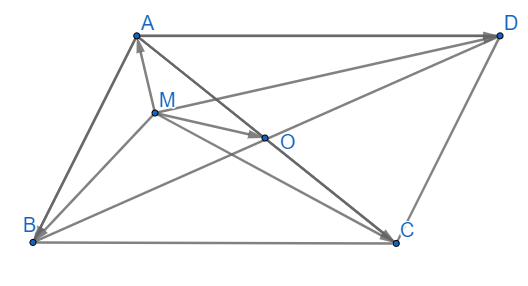
![]() \(\Leftrightarrow \overrightarrow {MO} + \overrightarrow {OA} + \overrightarrow {MO} + \overrightarrow {OB} + \overrightarrow {MO} + \overrightarrow {OC} + \overrightarrow {MO} + \overrightarrow {OD} = 4\overrightarrow {MO}\)
\(\Leftrightarrow \overrightarrow {MO} + \overrightarrow {OA} + \overrightarrow {MO} + \overrightarrow {OB} + \overrightarrow {MO} + \overrightarrow {OC} + \overrightarrow {MO} + \overrightarrow {OD} = 4\overrightarrow {MO}\)
a)![]() \(\overrightarrow {MA} + \overrightarrow {MB} + \overrightarrow {MC} + \overrightarrow {MD} = 4\overrightarrow {MO}\)
\(\overrightarrow {MA} + \overrightarrow {MB} + \overrightarrow {MC} + \overrightarrow {MD} = 4\overrightarrow {MO}\)
![]() \(\Leftrightarrow 4\overrightarrow {MO} + \left( {\overrightarrow {OA} + \overrightarrow {OB} } \right) + \left( {\overrightarrow {OC} + \overrightarrow {OD} } \right) = 4\overrightarrow {MO}\)
\(\Leftrightarrow 4\overrightarrow {MO} + \left( {\overrightarrow {OA} + \overrightarrow {OB} } \right) + \left( {\overrightarrow {OC} + \overrightarrow {OD} } \right) = 4\overrightarrow {MO}\)
 \(\Leftrightarrow 4\overrightarrow {MO} + \overrightarrow 0 + \overrightarrow 0 = 4\overrightarrow {MO} \\ \Leftrightarrow 4\overrightarrow {MO} = 4\overrightarrow {MO}\) (luôn đúng)
\(\Leftrightarrow 4\overrightarrow {MO} + \overrightarrow 0 + \overrightarrow 0 = 4\overrightarrow {MO} \\ \Leftrightarrow 4\overrightarrow {MO} = 4\overrightarrow {MO}\) (luôn đúng)
(vì O là giao điểm 2 đường chéo nên là trung điểm của AB, CD)
b) ABCD là hình bình hành nên ta có ![]() \(\overrightarrow {AB} + \overrightarrow {AD} = \overrightarrow {AC}\)
\(\overrightarrow {AB} + \overrightarrow {AD} = \overrightarrow {AC}\)
Suy ra ![]() \(\overrightarrow {AB} + \overrightarrow {AC} + \overrightarrow {AD} = \left( {\overrightarrow {AB} + \overrightarrow {AD} } \right) + \overrightarrow {AC} = \overrightarrow {AC} + \overrightarrow {AC} = 2\overrightarrow {AC}\)(đpcm)
\(\overrightarrow {AB} + \overrightarrow {AC} + \overrightarrow {AD} = \left( {\overrightarrow {AB} + \overrightarrow {AD} } \right) + \overrightarrow {AC} = \overrightarrow {AC} + \overrightarrow {AC} = 2\overrightarrow {AC}\)(đpcm)
Bài 2 trang 97
Cho tứ giác ABCD gọi M và N lần lượt là trung điểm của các cạnh AB và CD . Chứng minh rằng
![]() \(a) \overrightarrow {AC} + \overrightarrow {BD} = 2\overrightarrow {MN}\)
\(a) \overrightarrow {AC} + \overrightarrow {BD} = 2\overrightarrow {MN}\)
![]() \(b) \overrightarrow {AC} + \overrightarrow {BD} = \overrightarrow {BC} + \overrightarrow {AD}\)
\(b) \overrightarrow {AC} + \overrightarrow {BD} = \overrightarrow {BC} + \overrightarrow {AD}\)
Gợi ý đáp án
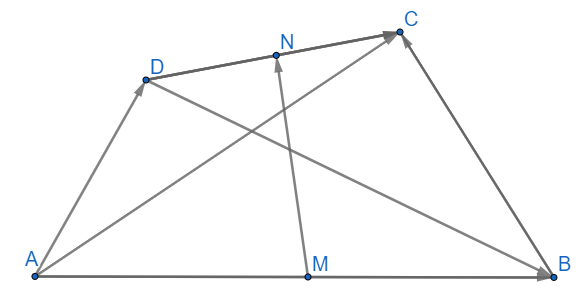
 \(a) \overrightarrow {AC} + \overrightarrow {BD} = \overrightarrow {AM} + \overrightarrow {MN} + \overrightarrow {NC} + \overrightarrow {BM} + \overrightarrow {MN} + \overrightarrow {ND} \\= \left( {\overrightarrow {AM} + \overrightarrow {BM} } \right) + \left( {\overrightarrow {MN} + \overrightarrow {MN} } \right) + \left( {\overrightarrow {NC} + \overrightarrow {ND} } \right)\)
\(a) \overrightarrow {AC} + \overrightarrow {BD} = \overrightarrow {AM} + \overrightarrow {MN} + \overrightarrow {NC} + \overrightarrow {BM} + \overrightarrow {MN} + \overrightarrow {ND} \\= \left( {\overrightarrow {AM} + \overrightarrow {BM} } \right) + \left( {\overrightarrow {MN} + \overrightarrow {MN} } \right) + \left( {\overrightarrow {NC} + \overrightarrow {ND} } \right)\)
![]() \(= \overrightarrow 0 + 2\overrightarrow {MN} + \overrightarrow 0 = 2\overrightarrow {MN}\)(đpcm)
\(= \overrightarrow 0 + 2\overrightarrow {MN} + \overrightarrow 0 = 2\overrightarrow {MN}\)(đpcm)
b) ![]() \(\overrightarrow {AC} + \overrightarrow {BD} = \overrightarrow {BC} + \overrightarrow {AD}\)
\(\overrightarrow {AC} + \overrightarrow {BD} = \overrightarrow {BC} + \overrightarrow {AD}\)
![]() \(\overrightarrow {BC} + \overrightarrow {AD} = \overrightarrow {BM} + \overrightarrow {MN} + \overrightarrow {NC} + \overrightarrow {AM} + \overrightarrow {MN} + \overrightarrow {ND}\)
\(\overrightarrow {BC} + \overrightarrow {AD} = \overrightarrow {BM} + \overrightarrow {MN} + \overrightarrow {NC} + \overrightarrow {AM} + \overrightarrow {MN} + \overrightarrow {ND}\)
![]() \(\left( {\overrightarrow {BM} + \overrightarrow {AM} } \right) + \left( {\overrightarrow {MN} + \overrightarrow {MN} } \right) + \left( {\overrightarrow {NC} + \overrightarrow {ND} } \right) = 2\overrightarrow {MN}\)
\(\left( {\overrightarrow {BM} + \overrightarrow {AM} } \right) + \left( {\overrightarrow {MN} + \overrightarrow {MN} } \right) + \left( {\overrightarrow {NC} + \overrightarrow {ND} } \right) = 2\overrightarrow {MN}\)
Mặt khác ta có: ![]() \(\overrightarrow {AC} + \overrightarrow {BD} = 2\overrightarrow {MN}\)
\(\overrightarrow {AC} + \overrightarrow {BD} = 2\overrightarrow {MN}\)
Suy ra ![]() \(\overrightarrow {AC} + \overrightarrow {BD} = \overrightarrow {BC} + \overrightarrow {AD}\)
\(\overrightarrow {AC} + \overrightarrow {BD} = \overrightarrow {BC} + \overrightarrow {AD}\)
Bài 3 trang 97
Cho hai điểm phân biệt A và B. Xác định điểm M sao cho ![]() \(\overrightarrow {MA} + 4\overrightarrow {MB} = \overrightarrow 0\)
\(\overrightarrow {MA} + 4\overrightarrow {MB} = \overrightarrow 0\)
Gợi ý đáp án
![]() \(\overrightarrow {MA} + 4\overrightarrow {MB} = \overrightarrow 0 \Leftrightarrow \overrightarrow {MA} = - 4\overrightarrow {MB} \Rightarrow \frac{{MA}}{{MB}}\)
\(\overrightarrow {MA} + 4\overrightarrow {MB} = \overrightarrow 0 \Leftrightarrow \overrightarrow {MA} = - 4\overrightarrow {MB} \Rightarrow \frac{{MA}}{{MB}}\)
 \(= \frac{{\left| {\overrightarrow {MA} } \right|}}{{\left| {\overrightarrow {MB} } \right|}} = \frac{{\left| { - 4\overrightarrow {MB} } \right|}}{{\left| {\overrightarrow {MB} } \right|}} = 4 và hai vectơ \overrightarrow {MA} ,\overrightarrow {MB}\) ngược hướng
\(= \frac{{\left| {\overrightarrow {MA} } \right|}}{{\left| {\overrightarrow {MB} } \right|}} = \frac{{\left| { - 4\overrightarrow {MB} } \right|}}{{\left| {\overrightarrow {MB} } \right|}} = 4 và hai vectơ \overrightarrow {MA} ,\overrightarrow {MB}\) ngược hướng
Suy ra M nằm giữa AB sao cho ![]() \(\frac{{MA}}{{MB}} = 4\)
\(\frac{{MA}}{{MB}} = 4\)
Bài 4 trang 97
Cho tứ giác ABCD. Gọi E, F, G lần lượt là trung điểm của các đoạn thẳng AB, CD, EF. Lấy điểm M tùy ý, chứng minh rằng ![]() \(\overrightarrow {MA} + \overrightarrow {MB} + \overrightarrow {MC} + \overrightarrow {MD} = 4\overrightarrow {MG}\)
\(\overrightarrow {MA} + \overrightarrow {MB} + \overrightarrow {MC} + \overrightarrow {MD} = 4\overrightarrow {MG}\)
Gợi ý đáp án
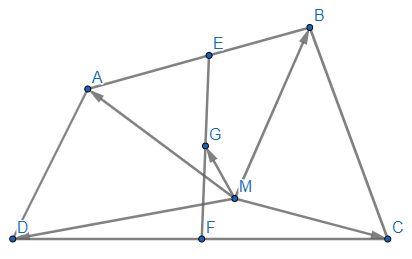
 \(\begin{array}{l}\overrightarrow {MA} + \overrightarrow {MB} + \overrightarrow {MC} + \overrightarrow {MD} = \left( {\overrightarrow {MG} + \overrightarrow {GE} + \overrightarrow {EA} } \right) + \left( {\overrightarrow {MG} + \overrightarrow {GE} + \overrightarrow {EB} } \right) + \left( {\overrightarrow {MG} + \overrightarrow {GF} + \overrightarrow {FC} } \right)\\ + \left( {\overrightarrow {MG} + \overrightarrow {GF} + \overrightarrow {FD} } \right)\end{array}\)
\(\begin{array}{l}\overrightarrow {MA} + \overrightarrow {MB} + \overrightarrow {MC} + \overrightarrow {MD} = \left( {\overrightarrow {MG} + \overrightarrow {GE} + \overrightarrow {EA} } \right) + \left( {\overrightarrow {MG} + \overrightarrow {GE} + \overrightarrow {EB} } \right) + \left( {\overrightarrow {MG} + \overrightarrow {GF} + \overrightarrow {FC} } \right)\\ + \left( {\overrightarrow {MG} + \overrightarrow {GF} + \overrightarrow {FD} } \right)\end{array}\)
![]() \(= \left( {\overrightarrow {MG} + \overrightarrow {MG} + \overrightarrow {MG} \overrightarrow { + MG} } \right) + 2\left( {\overrightarrow {GE} + \overrightarrow {GF} } \right) + \left( {\overrightarrow {EA} + \overrightarrow {EB} } \right) + \left( {\overrightarrow {FC} + \overrightarrow {FD} } \right)\)
\(= \left( {\overrightarrow {MG} + \overrightarrow {MG} + \overrightarrow {MG} \overrightarrow { + MG} } \right) + 2\left( {\overrightarrow {GE} + \overrightarrow {GF} } \right) + \left( {\overrightarrow {EA} + \overrightarrow {EB} } \right) + \left( {\overrightarrow {FC} + \overrightarrow {FD} } \right)\)
![]() \(= 4\overrightarrow {MG} + 2.\overrightarrow 0 + \overrightarrow 0 + \overrightarrow 0 = 4\overrightarrow {MG}\)(đpcm)
\(= 4\overrightarrow {MG} + 2.\overrightarrow 0 + \overrightarrow 0 + \overrightarrow 0 = 4\overrightarrow {MG}\)(đpcm)
Bài 5 trang 97
Máy bay A đang bay về hướng Đông Bắc với tốc độ 600 km/h. Cùng lúc đó, máy bay B đang bay về hướng Tây Nam với tốc độ 800 km/h. Biểu diễn vectơ vận tốc \overrightarrow b của máy bay B theo vectơ vận tốc ![]() \(\overrightarrow a\) của máy bay A
\(\overrightarrow a\) của máy bay A
Gợi ý đáp án
vectơ ![]() \(\overrightarrow a ,\;\overrightarrow b\) là vectơ vận tốc của máy bay A và máy bay b.
\(\overrightarrow a ,\;\overrightarrow b\) là vectơ vận tốc của máy bay A và máy bay b.
Do đó ![]() \(\left| {\overrightarrow a } \right|,\;\left| {\overrightarrow b } \right|\) lần lượt là độ lớn của vectơ vận tốc tương ứng.
\(\left| {\overrightarrow a } \right|,\;\left| {\overrightarrow b } \right|\) lần lượt là độ lớn của vectơ vận tốc tương ứng.
Ta có:![]() \(\left| {\overrightarrow a } \right| = 600,\;\left| {\overrightarrow b } \right| = 800\)
\(\left| {\overrightarrow a } \right| = 600,\;\left| {\overrightarrow b } \right| = 800\)
 \(\Rightarrow \frac{{\left| {\overrightarrow b } \right|}}{{\left| {\overrightarrow a } \right|}} = \frac{{800}}{{600}} = \frac{4}{3}\)
\(\Rightarrow \frac{{\left| {\overrightarrow b } \right|}}{{\left| {\overrightarrow a } \right|}} = \frac{{800}}{{600}} = \frac{4}{3}\)
Hai hướng Đông Bắc và Tây Nam là ngược nhau, do đó ![]() \(\overrightarrow b = - \frac{4}{3}\overrightarrow a\)
\(\overrightarrow b = - \frac{4}{3}\overrightarrow a\)
Bài 6 trang 97
Cho 2 điểm phân biệt A và B
a) Xác định điểm O sao cho ![]() \(\overrightarrow {OA} + 3\overrightarrow {OB} = \overrightarrow 0\)
\(\overrightarrow {OA} + 3\overrightarrow {OB} = \overrightarrow 0\)
b) Chứng minh rằng với mọi điểm M, ta có ![]() \(\overrightarrow {MA} + 3\overrightarrow {MB} = 4\overrightarrow {MO}\)
\(\overrightarrow {MA} + 3\overrightarrow {MB} = 4\overrightarrow {MO}\)
Gợi ý đáp án
![]() \(a) \overrightarrow {OA} + 3\overrightarrow {OB} = \overrightarrow 0\)
\(a) \overrightarrow {OA} + 3\overrightarrow {OB} = \overrightarrow 0\)
 \(\begin{array}{l}
\overrightarrow {OA} + 3\overrightarrow {OB} = \vec 0\\
\Leftrightarrow \overrightarrow {OB} + \overrightarrow {BA} + 3\overrightarrow {OB} = \vec 0\\
\Leftrightarrow \overrightarrow {OB} + 3\overrightarrow {OB} = - \overrightarrow {BA} \\
\Leftrightarrow 4\overrightarrow {OB} = \overrightarrow {AB} \\
\Leftrightarrow \overrightarrow {OB} = \frac{1}{4}\overrightarrow {AB}
\end{array}\)
\(\begin{array}{l}
\overrightarrow {OA} + 3\overrightarrow {OB} = \vec 0\\
\Leftrightarrow \overrightarrow {OB} + \overrightarrow {BA} + 3\overrightarrow {OB} = \vec 0\\
\Leftrightarrow \overrightarrow {OB} + 3\overrightarrow {OB} = - \overrightarrow {BA} \\
\Leftrightarrow 4\overrightarrow {OB} = \overrightarrow {AB} \\
\Leftrightarrow \overrightarrow {OB} = \frac{1}{4}\overrightarrow {AB}
\end{array}\)
Vậy O thuộc đoạn AB sao cho ![]() \(OB = \frac{1}{4}AB\)
\(OB = \frac{1}{4}AB\)
b) Ta có:

 \(\begin{array}{l}
\overrightarrow {MA} + 3\overrightarrow {MB} = \left( {\overrightarrow {MO} + \overrightarrow {OA} } \right) + 3\left( {\overrightarrow {MO} + \overrightarrow {OB} } \right)\\
= \left( {\overrightarrow {MO} + 3\overrightarrow {MO} } \right) + \left( {\overrightarrow {OA} + 3\overrightarrow {OB} } \right)\\
= 4\overrightarrow {MO} + \overrightarrow 0 = 4\overrightarrow {MO} . (đpcm)
\end{array}\)
\(\begin{array}{l}
\overrightarrow {MA} + 3\overrightarrow {MB} = \left( {\overrightarrow {MO} + \overrightarrow {OA} } \right) + 3\left( {\overrightarrow {MO} + \overrightarrow {OB} } \right)\\
= \left( {\overrightarrow {MO} + 3\overrightarrow {MO} } \right) + \left( {\overrightarrow {OA} + 3\overrightarrow {OB} } \right)\\
= 4\overrightarrow {MO} + \overrightarrow 0 = 4\overrightarrow {MO} . (đpcm)
\end{array}\)
Bài 7 trang 97
Cho tam giác ABC
a) Xác định các điểm M, N, P thỏa mãn: ![]() \(\overrightarrow {MB} = \frac{1}{2}\overrightarrow {BC} ,\overrightarrow {AN} = 3\overrightarrow {NB} ,\overrightarrow {CP} = \overrightarrow {PA}\)
\(\overrightarrow {MB} = \frac{1}{2}\overrightarrow {BC} ,\overrightarrow {AN} = 3\overrightarrow {NB} ,\overrightarrow {CP} = \overrightarrow {PA}\)
b) Biểu thị mỗi vectơ ![]() \(\overrightarrow {MN} ,\overrightarrow {MP}\) theo hai vectơ
\(\overrightarrow {MN} ,\overrightarrow {MP}\) theo hai vectơ ![]() \(\overrightarrow {BC} ,\overrightarrow {BA}\)
\(\overrightarrow {BC} ,\overrightarrow {BA}\)
c) Chứng minh ba điểm M, N, P thẳng hàng
Gợi ý đáp án
a) Ta có:
+) ![]() \(\overrightarrow {MB} = \frac{1}{2}\overrightarrow {BC} \Rightarrow \overrightarrow {MB}\) và
\(\overrightarrow {MB} = \frac{1}{2}\overrightarrow {BC} \Rightarrow \overrightarrow {MB}\) và ![]() \(\overrightarrow {BC}\) cùng hướng; tỉ số độ dài
\(\overrightarrow {BC}\) cùng hướng; tỉ số độ dài ![]() \(\frac{{BC}}{{MB}} = 2\)
\(\frac{{BC}}{{MB}} = 2\)
![]() \(\Rightarrow M\) nằm ngoài đoạn thẳng BC sao cho
\(\Rightarrow M\) nằm ngoài đoạn thẳng BC sao cho ![]() \(MB = \frac{1}{2}BC\)
\(MB = \frac{1}{2}BC\)
![]() \(+) {\overrightarrow {AN} = 3\overrightarrow {NB} \Rightarrow \overrightarrow {AB} + \overrightarrow {BN} = 3\overrightarrow {NB} \Rightarrow 4\overrightarrow {NB} = \overrightarrow {AB} \Leftrightarrow \overrightarrow {NB} = \frac{1}{4}\overrightarrow {AB} }\)
\(+) {\overrightarrow {AN} = 3\overrightarrow {NB} \Rightarrow \overrightarrow {AB} + \overrightarrow {BN} = 3\overrightarrow {NB} \Rightarrow 4\overrightarrow {NB} = \overrightarrow {AB} \Leftrightarrow \overrightarrow {NB} = \frac{1}{4}\overrightarrow {AB} }\)
![]() \(\Rightarrow N\) thuộc đoạn thẳng AB và
\(\Rightarrow N\) thuộc đoạn thẳng AB và ![]() \(NB=\frac{{1}}{{4}} AB\)
\(NB=\frac{{1}}{{4}} AB\)
![]() \(+) \overrightarrow {CP} = \overrightarrow {PA} \Leftrightarrow \overrightarrow {PC} + \overrightarrow {PA} = \overrightarrow 0\)
\(+) \overrightarrow {CP} = \overrightarrow {PA} \Leftrightarrow \overrightarrow {PC} + \overrightarrow {PA} = \overrightarrow 0\)
![]() \(\Rightarrow P\) là trung điểm của CA
\(\Rightarrow P\) là trung điểm của CA
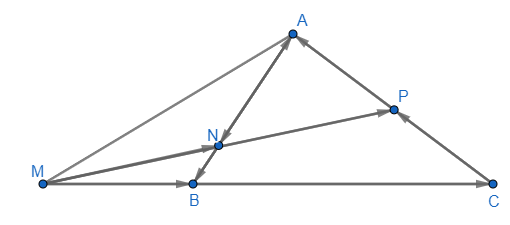
![]() \(b) \overrightarrow {MN} = \overrightarrow {MB} + \overrightarrow {BN} = \frac{1}{2}\overrightarrow {BC} + \frac{1}{4}\overrightarrow {BA}\)
\(b) \overrightarrow {MN} = \overrightarrow {MB} + \overrightarrow {BN} = \frac{1}{2}\overrightarrow {BC} + \frac{1}{4}\overrightarrow {BA}\)
 \(\begin{array}{l}\overrightarrow {MP} = \overrightarrow {MC} + \overrightarrow {CP} = \overrightarrow {MC} + \frac{1}{2}\overrightarrow {CA} \\= \frac{3}{2}\overrightarrow {BC} + \frac{1}{2}\left( {\overrightarrow {BA} - \overrightarrow {BC} } \right)\\ = \overrightarrow {BC} + \frac{1}{2}\overrightarrow {BA} \end{array}\)
\(\begin{array}{l}\overrightarrow {MP} = \overrightarrow {MC} + \overrightarrow {CP} = \overrightarrow {MC} + \frac{1}{2}\overrightarrow {CA} \\= \frac{3}{2}\overrightarrow {BC} + \frac{1}{2}\left( {\overrightarrow {BA} - \overrightarrow {BC} } \right)\\ = \overrightarrow {BC} + \frac{1}{2}\overrightarrow {BA} \end{array}\)
c) Ta có:
![]() \(\overrightarrow {MN} = \frac{1}{2}\overrightarrow {BC} + \frac{1}{4}\overrightarrow {BA} ; \overrightarrow {MP} = \overrightarrow {BC} + \frac{1}{2}\overrightarrow {BA}\)
\(\overrightarrow {MN} = \frac{1}{2}\overrightarrow {BC} + \frac{1}{4}\overrightarrow {BA} ; \overrightarrow {MP} = \overrightarrow {BC} + \frac{1}{2}\overrightarrow {BA}\)
![]() \(\Rightarrow \overrightarrow {MP} = 2\overrightarrow {MN}\)
\(\Rightarrow \overrightarrow {MP} = 2\overrightarrow {MN}\)
Vậy M,N,P thẳng hàng
Lý thuyết Tích của một số với một vectơ
+) Tích của một vectơ ![]() \(\overrightarrow a \ne \overrightarrow 0\)với một số thực k là một vectơ, kí kiệu là
\(\overrightarrow a \ne \overrightarrow 0\)với một số thực k là một vectơ, kí kiệu là ![]() \(k\overrightarrow a\).
\(k\overrightarrow a\).
+) vectơ ![]() \(k\overrightarrow a\)có độ dài bằng
\(k\overrightarrow a\)có độ dài bằng ![]() \(\left| k \right|\left| {\overrightarrow a } \right|\) và
\(\left| k \right|\left| {\overrightarrow a } \right|\) và
Cùng hướng với vectơ ![]() \(\overrightarrow a\)nếu k > 0
\(\overrightarrow a\)nếu k > 0
Ngược hướng với vectơ ![]() \(\overrightarrow a\)nếu k < 0
\(\overrightarrow a\)nếu k < 0
+) Quy ước:  \(k\overrightarrow a = \overrightarrow 0 \Leftrightarrow \left[ \begin{array}{l}\overrightarrow a = \overrightarrow 0 \\k = 0\end{array} \right.\)
\(k\overrightarrow a = \overrightarrow 0 \Leftrightarrow \left[ \begin{array}{l}\overrightarrow a = \overrightarrow 0 \\k = 0\end{array} \right.\)
Nhận xét: Hai vectơ ![]() \(\overrightarrow a\)và
\(\overrightarrow a\)và ![]() \(\overrightarrow b\)cùng phương khi và chỉ khi tồn tại k để
\(\overrightarrow b\)cùng phương khi và chỉ khi tồn tại k để ![]() \(\overrightarrow a = k\overrightarrow b .\)
\(\overrightarrow a = k\overrightarrow b .\)
Theo Nghị định 147/2024/ND-CP, bạn cần xác thực tài khoản trước khi sử dụng tính năng này. Chúng tôi sẽ gửi mã xác thực qua SMS hoặc Zalo tới số điện thoại mà bạn nhập dưới đây:












 Toán 10 Kết nối tri thức
Toán 10 Kết nối tri thức
 Toán 10 Chân trời sáng tạo
Toán 10 Chân trời sáng tạo
 Toán 10 Cánh Diều
Toán 10 Cánh Diều
 Soạn văn 10 Chân trời sáng tạo
Soạn văn 10 Chân trời sáng tạo
 Soạn văn 10 Cánh Diều
Soạn văn 10 Cánh Diều
 Soạn văn 10 Kết nối tri thức
Soạn văn 10 Kết nối tri thức
 Tiếng Anh 10 Global Success
Tiếng Anh 10 Global Success
 Tiếng anh 10 Friends Global
Tiếng anh 10 Friends Global
 Tiếng Anh 10 Explore New Worlds
Tiếng Anh 10 Explore New Worlds








